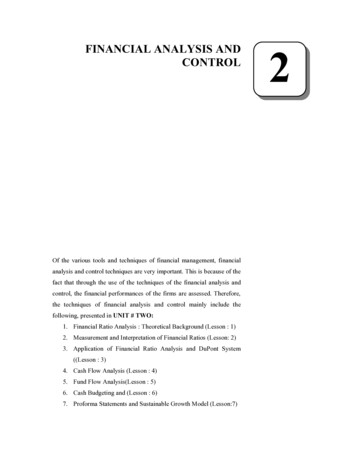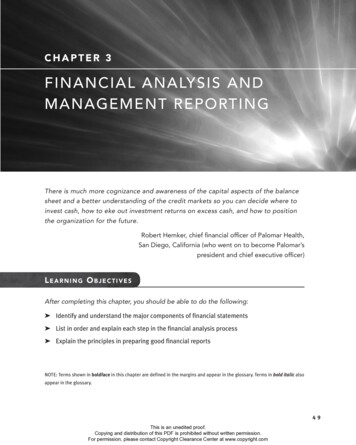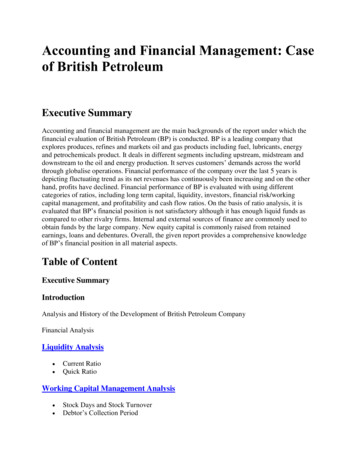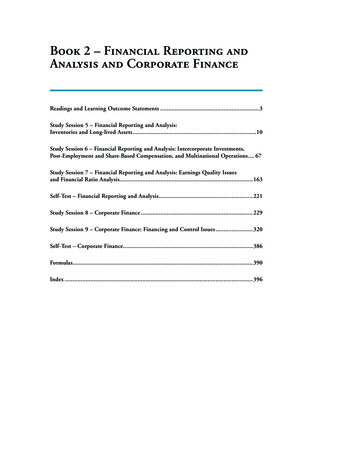
Transcription
FINANCIAL ANALYSIS ANDCONTROLOf the various tools and techniques of financial management, financialanalysis and control techniques are very important. This is because of thefact that through the use of the techniques of the financial analysis andcontrol, the financial performances of the firms are assessed. Therefore,the techniques of financial analysis and control mainly include thefollowing, presented in UNIT # TWO:1. Financial Ratio Analysis : Theoretical Background (Lesson : 1)2. Measurement and Interpretation of Financial Ratios (Lesson: 2)3. Application of Financial Ratio Analysis and DuPont System((Lesson : 3)4. Cash Flow Analysis (Lesson : 4)5. Fund Flow Analysis(Lesson : 5)6. Cash Budgeting and (Lesson : 6)7. Proforma Statements and Sustainable Growth Model (Lesson:7)2
School of BusinessBlankUnit-2Page-86
Bangladesh Open UniversityLesson-1:Financial Ratio Analysis:Theoretical BackgroundAfter carefully studying the lesson 1, you should be able : To know the concepts of financial ratio and its analysis; To get useful information from financial statements; To identify the users of financial ratio analysis; To understand the significance of financial ratio analysis; To identify the various types of financial ratios; To show the application of financial ratios and To understand the limitations of financial ratios.Concepts of Financial Ratio and Its AnalysisFinancial ratio embraces the relationship between two financial data.These financial data are available in profit and loss account or incomestatement and balance sheet of a firm. The analysis of financialstatements can be best done when financial data are expressed as ratiosor percentages. Ratio analysis is certainly a very admirable devicebecause it is simple and has a predictive value.Financial ratioembraces therelationshipbetween twofinancial data.Financial analysis is the interpretation of the financial statements of afirm. Financial analysis offers a system of appraisal and evaluation of afirm’s performance. The financial statements mainly include : (i) profitand loss account or income statement; (ii) balance sheet or statement ofaffairs; (iii) Statement of retained earnings; (iv) Cash flow statement and(v) fund flow statement.Financial analysisoffers a system ofappraisal andevaluation of afirm’s performance.Useful Information of Financial Statements for FinancialRatiosFinancial statements are those, which provide useful financialinformation of a firm. They are usually prepared at the end of a particularperiod, normally say, a year. The financial statements provide usefulinformation regarding the financial position of the enterprises. Theproper analyses of these statements provide valuable insight into thefinancial conditions and operations of an enterprise. That is, thesestatements help financial management of the enterprises in measuring theefficiency or otherwise of their financial policies and decisions. Theincome statement or profit and loss account indicates earning capacityi.e. profitability of an enterprise. That is, whether a firm is making profitor incurring loss in a particular financial year is reflected in the incomestatement. The balance sheet of a firm shows the financial position at theend of a financial period. The nature as well as the composition of assetsand liabilities, properties and capital is also reflected in the balance sheet.Statement of retained earnings reflects the changes in the firm’s retainedearnings as a result of the income generated and retained during the year.Cash flow statement shows the various sources and uses of cash; whereasthe fund flow statement shows the various sources and uses of funds.Fundamentals of Financial ManagementPage-87Financial statementshelp financialmanagement of theenterprises inmeasuring theefficiency orotherwise of theirfinancial policiesand decisions.
School of BusinessUsers of Financial RatiosFinancial ratios areused by the ownersand financialmanagement of afirm in order toevaluate thefinancial strengthsand weakness of thefirm.Financial ratios are used by the owners and financial management of afirm in order to evaluate the financial strengths and weakness of the firm.Financial ratios can also be used by parties outside the firms viz.creditors, investors and others. The nature of analysis will differdepending on the purpose of the users. However, the following internalas well as external parties may use financial ratios:(i)Owners : The owners of a firm are mainly interested in the firm’sprofitability, liquidity and hence survival. Therefore, they needfinancial ratios to test all these parameters of the firm.(ii)Financial managers : The financial managers of a firm regularlyuse the financial ratio analysis in order to evaluate the financialpolicies and decisions of the firm. It is the overall responsibilitiesof the financial managers to see that the financial resources of thefirm are used most effectively and efficiently and that the financialpositions of the firms are sound.(iii) Investors : Investors who have invested their funds in the firm aremostly concerned about the firm’s earnings.In financialanalysis, ratios arehelpful as abenchmark forevaluating thefinancial positionand performance ofa firm.(iv)Creditors : They are interested in a firm’s ability to meet theirclaims over a short period of time say one year. Hence, they usefinancial ratio analysis in order to evaluate the firm’s liquidityposition.(v)Financiers of Long-term Funds : They are concerned with thefirm’s long-term solvency and survival; since they provide longterm funds to firm. They analyze the firm’s profitability over time,its ability to generate cash to be able to pay interest and repay theprincipal amount. They do not analyze the historical financialstatements; but they put emphasis on the firm’s projected orproforma financial statements to test its future solvency andprofitability.(vi)Government : Government also analyze the financial position ofan enterprise, especially its net income, in order to see whether thetaxable income determined by the enterprise is correct or not.Government also analyze its sales position in order to seecorrectness of the same for imposing and collecting vat.Significance of Financial Ratio AnalysisRatio is a powerful test of financial analysis . In financial analysis, ratiosare helpful as a benchmark for evaluating the financial position andperformance of a firm. The absolute financial figures reported in thefinancial statements do not provide a meaningful understanding of theperformance of financial position of a firm. Therefore, a financial figurewhen related to another figure conveys a meaningful understanding. Asfor example, 5 million net profit earned in a financial year lookimpressive and also sound well; but do not bear testimony to the goodUnit-2Page-88
Bangladesh Open Universityfinancial condition. But, if net profit is related to sales or investment;only then the firm’s profitability can be predicted as good or bad ascompared to the previous year profitability. Financial ratios helpsummarizing large quantities of financial data and to make qualitativejudgment about the financial performance, based on quantitativejudgment. As for example, consider the case of current ratio of a firmduring particular financial year. Current ratio expresses the quantifiedrelationship between the current assets and current liabilities of that firmin that financial year. This relationship is an index or yardstick whichallows a qualitative judgment to be formed about the firm’s liquidity andhence ability to meet its current obligations. It measures the firm’sliquidity. The greater the ratio, the greater the firm’s liquidity and viceversa. Therefore, the point to note here that a financial ratio expresses aquantitative relationship; but also helps forming qualitative judgment.Such is the nature of all the financial ratios as will be discussed in thenext section 9.5.Financial ratios areused by the ownersand financialmanagement of afirm in order toevaluate thefinancial strengthsand weakness of thefirm.Types of Financial RatiosHaving regards to the specific interests of the relevant parties, internaland external; the financial ratios can be grouped into various classes. Asmentioned the main parties interested in financial ratios are short andlong-term creditors, owners, management, investors etc. Each of theseparties may require different financial ratios namely: (i) short-termcreditors’ main interest is in the liquidity position or short-term solvencyof the firm; (ii) long-term creditors’ main interest lies in the profitabilityand long-term solvency of the firm; (iii) owners’ main interest lies in theprofitability and financial position of the firm; (iv) investors’ maininterest is in the every aspect of the firm’s financial performance.Management will have to protect the interest of all other parties and seethat the firm grows profitably. Therefore, in view of the requirement ofthe various users of financial ratios, they may be classified into thefollowing important categories:(i)Liquidity ratios;(ii) Debt or leverage ratios;(iii) Coverage Ratios;(iv) Profitability ratios;(v) Activity Ratios / Asset Management Ratios and(vi) Market value ratios.In view of therequirement of thevarious users offinancial ratios, theymay be classifiedinto the followingimportantcategories : (i)Liquidity ratios;(ii)Debt or leverageratios;(iii) Coverageratios;(iv)Profitabilityratios; (v) ActivityRatios / AssetManagement Ratiosand (vi) Marketvalue ratios.Each of the above type of financial ratios is discussed in the followingsub-sections :Liquidity RatiosLiquidity ratios are those which measure the liquidity and hence theshort-term financial ability of a firm to meet its short-term financialobligations. These are : (i) current ratio; (ii) quick ratio; (iii) ratio of networking capital to total assets and (iv) cash ratio. The followingparagraphs deal with each of these ratios.Fundamentals of Financial ManagementPage-89These are : (i)current ratio; (ii)quick ratio; (iii)ratio of net workingcapital to totalassets and (iv) cashratio.
School of Business(i)Current Ratio : This ratio is the relationship between currentassets and current liabilities of a firm. The current assets include:cash in hand and in bank; debtors or accounts receivables; billreceivables; inventory and marketable securities and prepaidrevenue expenses. On the other hand, current liabilities include:sundry creditors, bills payable, bank over-drafts, short-term bankand other loans. This ratio measures the extent of the currentliabilities to current assets.(ii)Quick Ratio : This is also known as acid test ratio whichexpresses the relationship between quick assets and currentliabilities. Quick assets are current assets as reduced byinventories. This ratio is the variation of the current ratio. Thisratio measures the extent of the current liabilities to quick assets.(iii) Ratio of Networking Capital to Total Assets : This ratio is therelationship between networking capital and total assets of a firm.Net working capital means currents as reduced by currentliabilities. Total assets represent all the real assets, current andfixed having market values. So, fictitious assets, having no marketvalue, like preliminary expenses, discount on issue of shares, profitand loss account debit balance etc. are not included in total assets.This ratio measures the extent of net working capital to total assets.(iv)Cash Ratio : It is the relationship between cash bank balances andcurrent liabilities of a firm. This measures the adequacy orinadequacy of cash resources in order to meet the currentobligations of a firm.Debt or Leverage RatiosDebt or Leverageratios are thosewhich measure thelong-term solvencyof a firm. That iswhether a firm hasenough financialsolvency to meet itslong-termobligations ismeasured by debt orleverage ratios.These are : (i) debtequity ratio; (ii)debt ratio; (iii) ratioof cash flow to totalcapitalization; (iv)ratio of capitalemployed to networth and (v) equitymultiplier.Debt or Leverage ratios are those which measure the long-term solvencyof a firm. That is, whether a firm has enough financial solvency to meetits long-term obligations is measured by debt or leverage ratios. Theseare : (i) debt equity ratio; (ii) debt ratio; (iii) ratio of cash flow to totalcapitalization; (iv) ratio of capital employed to net worth and (v) equitymultiplier. The following paragraphs deals with them.(i)Debt Equity Ratio : This ratio is the relationship between thelong-term debt and equity of a firm. Long-term debts are thosewhose maturity period is more than one year. These include:debentures, bonds etc. Equity represents the ordinary or equityshare capital or stock of a firm. This ratio measures thecontribution of long-term creditors as well as that of the owners.So, it describes the long-term lenders’ contribution for each Taka/Dollar of the owners’ contribution.(ii)Debt Ratio : This ratio is the relationship between total debts bothlong-term and short-term to total assets of a firm. This ratiomeasures the percentage or extent of the firm’s total assetsfinanced by total creditors (borrowings). This ratio tells us therelative importance of total debts in the asset structure of a firm.Unit-2Page-90
Bangladesh Open University(iii) Ratio of Cash Flow to Total Capitalization : This ratio is therelationship between net cash flows and total capitalization of afirm. Net cash flow is the excess of cash in-flows over cashoutflows during a particular year plus opening cash and bankbalances. Total capitalization refers to the total capital, bothworking and fixed and log-term and short-term debts. It is ameasure of the ability of a firm to service its debts. This ratio isuseful in assessing the credit-worthiness of a firm seeking debtfunds.(iv)Ratio of Capital Employed to Net-worth : This ratio is therelationship between capital employed and net worth of firm.Capital employed refers to the sum of net working capital and realfixed assets as reduced by accumulated depreciation. Net-worthrefers to shareholders’ equity, which is composed of equity sharecapital or equity stock, retained earnings and general reserves. Thisratio measures how much funds are being contributed together bythe lenders and owners for each Taka/ Dollar of the owners’contribution.(v)Equity multiplier : It is the relationship between total assets andtotal equity. Total equity represents the equity share capital,retained earnings and general reserves and surplus which are due toowners of the company. This ratio measures how much ownedfunds are invested in total assets.Coverage RatiosCoverage ratios measure the ability to service debts of a firm. That is,coverage ratios are designed to relate the financial charges of a firm to itsability to service them. The various coverage ratios are : (i) Interestcoverage ratio; (ii) Cash flow coverage ratio and (iii) fixed chargecoverage ratio. The following paragraphs follow the discussion on eachof the coverage ratio.(i)Interest Coverage Ratio : This ratio is the relationship betweeninterest charges or financial charges and earnings before interestand taxes of a firm. This ratio is also known as time interest earnedratio. This ratio measure the extent to which the operating income(EBIT) can decline before the firm is unable to meet its interestobligations. This ratio, therefore, stresses on a firm’s meeting allfixed financial charges (interests), regardless of seniority of theclaim.(ii)Cash Flow Coverage Ratio : This ratio is the relationshipbetween net cash flows and the principal loan amount plus interestof a firm during a particular period. So, this ratio involves therelations of earnings before interest, taxes, depreciation andamortization (EBITDA) to interest and plus principal payments.This ratio measures a firm’s ability to service its interest paymentson a loan.Fundamentals of Financial ManagementPage-91Coverage ratiosmeasure the abilityto service debts of afirm. That is,coverage ratios aredesigned to relatethe financialcharges of a firm toits ability to servicethem. The variouscoverage ratios are:(i) Interest coverageratio; (ii) Cash flowcoverage ratio and(iii) fixed chargecoverage ratio.
School of Business(iii) Fixed Charge Coverage Ratio : This ratio is the relationshipbetween fixed charges and EBIT plus lease installment payments.Fixed charges include interest charges, annual lease payments andsinking funds payments. This ratio expands the Interest CoverageRatio to include the firm’s annual lease payments and sinkingfunds payments. This ratio measures the firm’s ability to pay allinterest charges including annual lease and sinking fund payments.Profitability RatiosThis ratio helpsmeasuring earningcapacity of a firm.These ratios mainlyinclude : (i) Grossprofit margin;( ii)Net profit margin;(iii) Return oninvestment; (iv)Return on equityand (v) Earning pershare.Profitability refers to the expression of profits in relation to sales,investment and equity of a firm. Here, profits may be gross profits, netprofits before and after interest and taxes. Whenever profits are related toany one of these parameters; then we get profitability ratio. This ratiohelps measuring earning capacity of a firm. These ratios mainly include :(i) Gross profit margin; (ii) Net profit margin; (iii) Return on investment;(iv) Return on equity and (v) Earning per share. The followingparagraphs deal with each of these ratios.(i)Gross Profit Margin : This ratio is the relationship between grossprofits and sales of a firm. Gross profit is the sales reduced byvariable expenses i.e. cost of goods sold. This ratio is also knownas contribution ratio. This ratio reflects the efficiency with whichthe management produces each unit of product.(ii)Net Profit Margin : This ratio is the relationship between netprofits and sales of a firm. Net profit refers to gross profits asreduced by fixed expenses. Net profits are also known as earningsafter interest and taxes (EAIT). This ratio indicates management’sefficiency in manufacturing, administering and selling anddistributing the products. It measures the earning capacity of afirm.(iii) Return on Investment (ROI) : This ratio is the relationship ofEAIT with investment, either total or net. Total investment refersto the sum total of all the real assets; whereas net investment refersto net assets i.e. total real assets as reduced by current liabilities.This ratio measures the extent of a firm’s earnings in relation to itsinvestment, total or net.(iv)Return on Equity (ROE) : This ratio is the relationship betweenEAIT and equity of a firm. Here, equity means shareholders’equity. This ratio measures the extent of firm’s earnings in relationto shareholders’ equity. ROE indicates how well the firm has usedthe owners’ resources.(v)Earnings Per Share (EPS) : The profitability of the equity orordinary or common shareholders’ investment can also bemeasured in determining EPS. This also indicates the earningcapacity of a firm. EPS found out over years indicates whether ornot the firm’s earnings power on the per-share basis has changedover that period.Unit-2Page-92
Bangladesh Open UniversityActivity Ratios/ Asset Management RatiosAsset management ratios are those which measure how effectively a firmis managing its assets. That is, they reflect the assets turnover throughwhich the performances of the assets are measured. These ratios include :(i) Inventory Turnover; (ii) Receivables Turnover; (iii) Fixed AssetsTurnover; (iv) Working Capital Turnover and (v) Total Assets Turnover.Each of these ratios is discussed in the following paragraphs:Inventory Turnover : It shows the relationship between cost of goodssold and inventories of a firm. Here, inventory refers to the average ofopening and closing inventories. This ratio indicates the efficiency of thefirm in producing and selling its products. This turnover shows howrapidly the inventory is turning into sales.(i)Receivables Turnover : It shows the relationship between creditsales and debtors or accounts receivables. When a year is dividedby receivables turnover, it is known as “Average CollectionPeriod” or “ Days Sales Outstanding”. It measures the quantity ofdebtors since it indicates the speed of their collection. Thus,receivables turnover evaluates the credit policy of a firm.Asset managementratios are thosewhich measure howeffectively a firm ismanaging its assets.These ratios include: (i) InventoryTurnover; (ii)ReceivablesTurnover; (iii)Fixed AssetsTurnover; (iv)Working CapitalTurnover and (v)Total AssetsTurnover.(ii) Fixed assets Turnover : This is the relation between the sales andfixed assets of a firm. This turnover measures the firm’s efficiencyin utilizing its fixed assets. Here, fixed assets refer to net fixedassets (gross fixed assets as reduced by accumulated depreciation).It indicates the firm’s ability to produce a value of sales for a givenamount of net fixed assets.(iii) Working Capital Turnover: This turnover expresses therelationship between working capital or current assets and sales. Itis also known as current assets turnover. It measures howefficiently the firm uses its current assets. It indicates the firm’sability to produce a volume of sales for a given amount of currentassets.(iv) Total assets Turnover: This turnover expresses the relationshipbetween total assets, both net fixed and current and sales. This isthe final asset management ratio, which measures how efficientlythe firm uses its total assets. It indicates the firm’s ability toproduce a volume of sales for a given amount of total assets.Market Value RatiosMarket value ratios represent a set of ratios that relate the firm’s stockprice to its earnings and book value per share. These ratios givemanagement an indication of what investors think of the firm’s pastperformance and future prospects. The market value ratios of a firmdepend on its liquidity, debt management and asset management ratios,coverage ratios and profitability ratios. If these ratios are satisfactory;then the market value ratios are also satisfactory and vice-versa. Themarket value ratios include : (i)price-earning ratio ; (ii) dividend yieldFundamentals of Financial ManagementPage-93Market value ratiosrepresent a set ofratios that relate thefirm’s stock price toits earnings andbook value pershare.
School of Businessand (iii) market-to-book ratio. The following paragraphs deal with eachof these ratios :The market valueratios include :(i)price-earningratio ; (ii) dividendyield and (iii)market-to-bookratio.(i)Price-earning Ratio: This ratio expresses the relationship betweenmarket price per share and earnings per share. This ratio showshow much the investors are willing to pay per Taka/ Dollar ofreported profits. It gives an indication of the relative valuation of astock/ share of a firm. It reflects investors’ expectation about thegrowth in the firm’s earnings.(ii)Dividend Yield : Dividend yield for a stock relates the annualdividend to share/ stock price. Dividend yield evaluates theshareholders’ returns in relation to the market value of the share/stock.(iii) Market-to-Book Ratio: This ratio expresses relationship betweenmarket price per share and book value per share. Book value pershare is the value of per common share/ outstanding. This ratiogives an indication of how investors regard the firm. That is, thismarket- to book value ratio is a relative measure of how the growthoption for a firm is being valued vis-a vis its physical assetsThey are used by themanagers andoutside parties forassessing theliquidity position,long-term solvency,operating efficiency,overall financialperformance, interfirm comparison,trend analysis andproforma analysisApplication of Financial RatiosAs the tool of financial analysis, financial ratios are applied by theowners/ shareholders, financial managers, production, marketing andhuman resource managers of a corporate firm for taking variousdecisions. Financial ratios are also applied by the creditors, investors,long-term financiers in assessing the financial performance of the firm inwhich they have vested interests. They are applied by the managers andoutside parties for assessing the performances of the firm in respect ofthe following aspects :a)Liquidity Position : Liquidity of a firm is of crucial significanceby the credit analysts of banks and other providers of the shortterm loans to that firm. Both the deficit and surplus liquidity areharmful for a firm. Shortage of liquidity hampers the ability of thefirm to meet its short-term financial obligations; while the surplusliquidity adversely affects the profitability of the firm in the sensethat it creates idle liquidity, leading to blockage of the funds intothe various current assets. Therefore, to examine whether a firmhas deficit or surplus liquidity, analysis of liquidity ratios is verymuch helpful.b)Long-term Solvency : Long-term solvency of a firm is of crucialimportance to the long-term creditors, security analysts and theexisting as well as potential owners of that firm. These parties areinterested in order to examine whether the firm is able to meet itslong-term financial obligations. The long-term solvency ismeasured by the debt or leverage ratios and profitability ratios,which focus on earning power. Analysis of these ratios reveals thestrength and weakness of a firm in this respect. For example, theleverage ratios will indicate whether a firm has a reasonableUnit-2Page-94
Bangladesh Open Universityproportion of various sources of finance in its capital structure; orwhether its capital structure is heavily burdened with debt in whichcase the firm’s solvency is exposed to serious strain. Similarly, thevarious profitability ratios would reveal whether or not the firm isable to offer adequate return to its owners consistent with the riskinvolved.(c)d)Operating Efficiency : Operating efficiency is a must for a firmfor survival. Such operating efficiency is dependent on the efficientand effective utilization of its assets, both fixed and current. Inorder to measure operating efficiency, asset management oractivity ratios are helpful. The analysis of these ratios throws lighton the degree of efficiency in the management and utilization of itsassets. In fact, the solvency of a firm is, in the ultimate analysis,dependent on the sales revenues generated by the use of its assetstotal as well as its components.Overall Financial Performance : Unlike the outside parties likethe creditors, owners, investors, financiers etc. who are interestedin any one aspect of the financial position of a firm, themanagement of the firm is constantly concerned about the overallfinancial performance of the firm. That is, the management isconcerned about the ability of a firm to meet its short-term as wellas long-term financial obligations to its creditors; to ensure areasonable return to its owners and ensure an optimum utilizationof the assets of the firm. This is possible if an integrated view istaken on all the financial ratios.(e) Inter-firm Comparison: Ratio analysis not only throws light onthe financial position of a firm but also serves as a stepping stoneto remedial measures. This is made possible due to inter-firmcomparison with industry averages. A single value of a particularratio is meaningless unless it is related to some standard or norm.One of the popular techniques is to compare the ratios of a firmwith the industry average. It should be reasonably expected that theperformance of a firm should be in broad conformity with that ofthe industry to which it belongs. An inter-firm comparison of theratios would demonstrate the relative position vis-a vis itscompetitors. If the value of any ratio differs from the industryaverage or from that of the competitors; the firm can enquire intothe probable reasons thereafter and in that light and take remedialmeasures.(f)Trend Analysis : Trend analysis or time series analysis of theratios is of crucial importance to a firm; since the analysis takesinto consideration the time dimension. Trend analysis of the ratiosenables to know whether the financial position of a firm isimproving or determining or has remained constant over the years.The significance of a trend analysis lies in the fact that the analystcan know the direction of movement/ change i.e. whether themovement/ change is favorable or unfavorable. The analyst shouldFundamentals of Financial ManagementPage-95
School of Businessalso identify the reasons for unfavorable change in the ratios sothat corrective measures may be initiated.(g)Proforma Analysis : Proforma ratio analysis is the analysis offuture ratios of a firm. The future ratios are sometimes used as thestandard of comparison. The future ratios can be developed fromthe projected or proforma financial statements. The comparison ofthe current or past ratios with the future ratios shows the firm’srelative strengths and weakness in the past and the future. If thefuture ratios indicate weak financial position, the firm shouldinitiate corrective measures as early as possible.Limitations of Financial RatioThese limitationsare – impact ofinflation, conceptualdiversity andwindow dressingtechnique.Although ratio analysis is a widely used tool of financial analysis; yet itsuffers from various limitations. These limitations are highlighted below:Difficulty in ComparisonInter-firm comparison is one of the main techniques of comparativeanalysis of ratios. But, each inter-firm comparison faces the followingmain difficulties :(i)Difference arisen in the basis of inventory valuation e.g. last infirst out, first in first out, average cost and cost;(ii) Differences arisen in the methods of depreciation like straight line,reducing balance, accelerated etc.;(iii) Differences arisen in estimating working life of fixed assets likeplant and machinery and equipment etc.;(iv) Differences arisen in amortization of intangible assets likegoo
Financial ratios are used by the owners and financial management of a firm in order to evaluate the financial strengths and weakness of the firm. Financial ratios can also be used by parties outside the firms viz. creditors, investors and others. The nature of an










